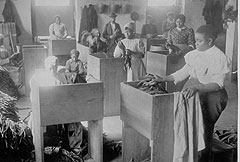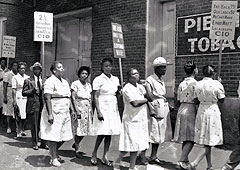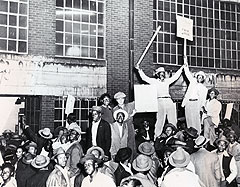Black Women Raise Their Voices in the Tobacco Industry
February 28, 2014
In the early 20th century, tobacco workers in the Southeast labored in factories under atrocious conditions. Black women were typically responsible for the unpleasant and demanding job of de-stemming tobacco leaves, which they did by hand. The “stemmers” were the lowest paid in the industry, and their wages depended on the amount of stemming they did each day. As the quantity of tobacco leaf rose and fell with the agricultural cycle, so did their pay.
The factory bosses often ruled with an iron fist. They treated the factories as if they were plantations, and the hiring process was reminiscent of slave auctions. “Foremen lined us up against the walls,” remembered one tobacco stemmer, “and chose the sturdy, robust ones.” Once hired, the women were subjected to verbal and physical abuse.
Even the buildings had changed very little since the days of slavery. The rooms were full of tobacco dust and the lack of ventilation made breathing diffcult. The tobacco was dirty and sticky, especially in the early months of the growing season, before it had time to dry.
The stemmers found solidarity in their plight and referred to each other as “sisters.” Despite the workers’ unity, the employers were cocky, believing that no labor union would try to organize workers in the tobacco industry.
A Tongue-Lashing
 By 1938, Louise “Mamma” Harris had worked at the I.N. Vaughan Export stemmery in Richmond VA for nearly six years. The women who worked at Export were among the poorest in Richmond; they had to wrap themselves in tobacco burlap to stay warm in the winter. The stemmers earned an average of $3 a week and often worked more than 90 hours in cramped, dirty conditions.
By 1938, Louise “Mamma” Harris had worked at the I.N. Vaughan Export stemmery in Richmond VA for nearly six years. The women who worked at Export were among the poorest in Richmond; they had to wrap themselves in tobacco burlap to stay warm in the winter. The stemmers earned an average of $3 a week and often worked more than 90 hours in cramped, dirty conditions.
Harris had been feuding with a male co-worker since the day she was hired. Every week he would scold and harass her – and she would take it. One day in the spring of 1938, when he started shouting, she stunned him by “giving him a tongue-lashing” in return.
He accused her of joining the union campaign that had started one week prior. The news of the campaign hadn’t reached Harris, but she was interested, so she began asking around.
Harris took 60 of her co-workers to the next meeting of the Tobacco Stemmers’ and Laborers’ Industrial Union. Sitting in the front row, when the organizers asked for volunteers, Mamma Harris jumped to her feet.
After winning support from 700 of the 1,000 employees who worked at Export, the time came to take a stand.
“We called our strike and closed up Export tight as a bass drum,” she remembered years later, “A couple hundred tried to break our line but we wasn’t giving a dog a bone.”
The job action worked. After 17 days on strike, the factory owner was forced to come to the bargaining table, conceding, “Times certainly changed.”
Times had changed. Using disgusting language, he reminisced that in days past he would fi re a black employee just for walking into his office. Now, the workers had won a wage increase, an eight-hour work day, and the right to engage in collective bargaining.
Upon seeing the success of the strike and observing Harris’ leadership, the Congress of Industrial Organizations (CIO) established the Tobacco Workers Organizing Committee, where Harris worked to organize other tobacco factories in Richmond.
The Moment of Truth
By 1943, tobacco workers had gained some protection under the Fair Labor Standards Act of 1938, including a 40-hour work week, a minimum wage of 40 cents per hour, and time-and-a-half for overtime. Still, tobacco stemmers in Winston-Salem NC earned barely half of what the federal government said was a “minimum subsistence of living.” Machine-stemming had replaced stemming by hand, but the work was no less tedious. Three women operated each machine. One would grab a handful of tobacco leaves, untie them, and pass them to a co-worker who spread the leaves flat. A third would feed the leaves onto a conveyer that carried them between two blades that cut the stem away from the leaves.
The start of World War II had driven up the demand for cigarettes and had depleted the workforce. Managers at R.J. Reynolds Tobacco responded by insisting on overtime, speeding up production, and increasing production quotas. Foremen walked the fl oors disciplining the women and checking their work.
Theodosia Gaither Simpson had started working at Reynolds in 1936, and within a few years she became part of the Tobacco Workers Organizing Committee.
Simpson and her co-workers couldn’t keep up with the demanding pace of the work and finally had enough. One co-worker remembered the tipping point, saying, “If you’d tell them they put too much work on you, they’d fi re you. It got so we wasn’t going to take it anymore; we had had it.”
On the morning of June 17, 1943, Simpson witnessed a co-worker being pushed too hard. The woman was sick, and couldn’t keep up the pace. The foreman said if she didn’t catch up, she would be fi red. She broke down in tears, moving Simpson to action.
Simpson called a few women together in the bathroom to plan a sit-down strike the next morning. She recalled telling her co-workers, “Let’s not work until we get some understanding on how these people are going to be treated.”
Management found out about the plan and warned the women that would lose their jobs if they stopped work. Instead of backing down, 200 women began the job action that afternoon.
Word spread quickly, and within minutes men and women in other parts of the factor joined the work stoppage.
R.J. Reynolds executives were quick to respond. John C. Whitaker, vice president of Manufacturing, and Edward Bumgardner, head of the Employment Office, demanded to know what was wrong.
Theodosia Simpson described some of the responses: “We can’t work this hard.” “I don’t make enough money to give my family a decent meal.” “We’re tired of these foremen treating us like dirt.”
Whitaker claimed the company was operating under wartime wage controls and could only raise wages with the government’s approval. Simpson countered that the Little Steel Formula, a 1942 decision by the National War Labor Board, allowed for modest pay increases for the duration of the war.
Whitaker finally conceded and suggested Simpson and her co-workers form a committee to meet with him the following day.
The workers didn’t back down. The strike spread, and soon the great R.J. Reynolds and many tobacco leaf houses were successfully organized. Local 22 of the Food, Tobacco, Agricultural and Allied Workers of America CIO was born, with brave African-American women like Theodosia Gaither Simpson as its heart and soul.
Sources:
Civil Rights Unionism: Tobacco Workers and the Struggle for Democracy in the Mid-twentieth-century South, by Robert Rodgers Korstad;
Major Problems in African-American History. Vol.2: From Freedom to ‘Freedom Now,’ 1865-1990s: Documents and Essays, by Thomas C. Holt and Elsa Barkley;
The Encyclopedia of Strikes in American History, by Aaron Brenner, Benjamin Day, and Immanuel Ness; U.S. Women in Struggle: A Feminist Studies Anthology, by Claire Goldberg Moses, and Heidi I. Hartmann;
Subversive Sisterhood: Black Women and Unions in the Southern Tobacco Industry, by Dolores E. Janiewski



